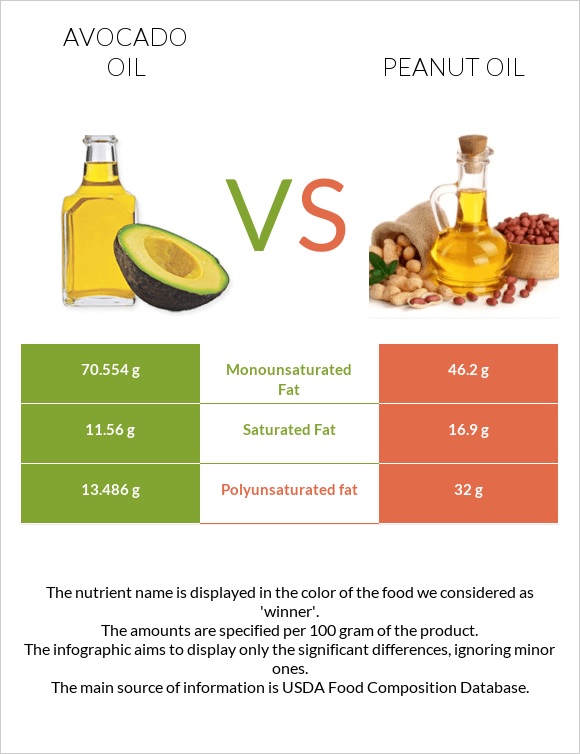Avocado oil vs. Peanut oil — Health Impact and Nutrition Comparison


Summary
Peanut oil is richer in polyunsaturated fats and vitamin E, giving it an advantage over avocado oil. In comparison, avocado oil is richer in monounsaturated fats and has a higher smoke point, which means it can be used more safely in cooking at high temperatures.
Introduction
This article is a comparison between 2 types of vegetable oils – peanut oil and avocado oil. We will review the general differences, nutritional content, and health impact.
By the end of the article, we will have gained an understanding of which oils are suitable for frying, their fat and nutritional profiles, and the specific health effects associated with each. With this knowledge in hand, you'll be equipped to make a more informed and healthy decision.
General differences
Types
There are two main types of avocado and peanut oils – virgin and refined. Virgin oil is the oil obtained from pressing. The oil made from the first pressing, without any chemicals or excessive heat, is what we refer to as extra-virgin oil. On the other hand, refined avocado or peanut oil is made by filtering the virgin oil for small particles.
In addition to these types, peanut oil can also be roasted. Roasted peanut oil is made from roasted peanuts and has a much stronger flavor.
Taste
When it comes to their flavor profile, peanut oil has a strong earthy and nutty taste, while avocado oil has the aromas of avocados, often compared to the taste of mushrooms. The more virgin the avocado oil, the less mushroomy flavor it has.
Smoke Point
Understanding the smoke point of each oil is crucial when it comes to using them in everyday cooking. Peanut oil has a smoke point of 232 °C, whereas avocado oil has a smoke point of 271 °C.
Keep in mind that the above-mentioned smoke points are for refined oils; extra-virgin or virgin types of both oils have slightly lower smoke points.
Avocado oil has the highest smoke point among plant-based cooking oils. This shows that both these oils can be used for frying; however, avocado oil is a safer option to be used in very high temperatures and has the minimum risk of releasing free radicals and carcinogenic compounds.
Cooking
Since both peanut oil and avocado oil have high smoke points compared to other types of cooking oils, both are good choices for high-heat cooking, such as sautéing, pan-frying, stir-frying, or deep frying. Both oils can also be used for baking.
Although it highly depends on the type of cooking, the flavor of avocado oil can become unnoticeable after cooking; hence, using it as a salad dressing is recommended if you want to retain its flavor in your dish. The same applies to peanut oil, especially roasted peanut oil, where the flavor is very distinguishable.
Nutritional Content Comparison
The serving size for oils is usually one teaspoon, which equals 4.5 grams for both avocado and peanut oils.
The calories in peanut oil and avocado oil are equal. For 4.5 grams of serving, they both provide 39.8 calories.
Fats
Both avocado oil and peanut oil are made of 100% fats; however, their fat profiles differ.
Avocado oil is lower in saturated fats and richer in monounsaturated fats. In comparison, peanut oil is richer in polyunsaturated fats.
One teaspoon of avocado oil consists of 0.533 grams of saturated fats, 3.18 grams of monounsaturated fats, and 0.607 grams of polyunsaturated fats. A similar serving of peanut oil, on the other hand, consists of 0.76 grams of saturated fats, 2.08 grams of monounsaturated fats, and 1.44 grams of polyunsaturated fats.
Fat Type Comparison
Contains
less
Sat. FatSaturated fat
-31.6%
Contains
more
Mono. FatMonounsaturated fat
+52.7%
Contains
more
Poly. FatPolyunsaturated fat
+137.3%
Vitamins
One teaspoon of peanut oil contains 0.706mg of Vitamin E, which is an adequate amount to fill up the daily need. Hence, whereas avocado oil does not contain any significant amount of vitamins, peanut oil is rich in Vitamin E.
Health Impact
Cardiovascular Health
Oils are high in calories and fats, which are directly related to an increased risk of cardiovascular diseases and metabolic diseases. However, in the case of avocado and peanut oils, they are mostly composed of unsaturated fats. Unsaturated fatty acids decrease the risks of heart disease and metabolic diseases. According to a study, this is because they have the potential to decrease the total and low-density lipoprotein (LDL cholesterol) while retaining the levels of high-density lipoprotein (HDL cholesterol) (1, 2, 3).
However, the discussion that follows questions which type of unsaturated fat has more benefits – monounsaturated or polyunsaturated. We can conclude that polyunsaturated fats have more positive health benefits than monounsaturated fats in decreasing the risks of cardiovascular diseases and metabolic diseases (4, 5).
Vitamin E Benefits
Peanut oil is richer in vitamin E and provides several health benefits. Vitamin E has antioxidative, anticarcinogenic, and immune-boosting properties (6).
Infographic

Mineral Comparison
Vitamin Comparison
All nutrients comparison - raw data values
| Nutrient |  |
 |
DV% diff. |
| Polyunsaturated fat | 13.486g | 32g | 123% |
| Vitamin E | 15.69mg | 105% | |
| Monounsaturated fat | 70.554g | 46.2g | 61% |
| Saturated fat | 11.56g | 16.9g | 24% |
| Vitamin K | 0.7µg | 1% | |
| Calories | 884kcal | 884kcal | 0% |
| Fats | 100g | 100g | 0% |
| Iron | 0mg | 0.03mg | 0% |
| Zinc | 0mg | 0.01mg | 0% |
| Choline | 0.1mg | 0% |
Macronutrient Comparison
People also compare
References
All the values for which the sources are not specified explicitly are taken from FDA’s Food Central. The exact link to the food presented on this page can be found below.
- Avocado oil - https://fdc.nal.usda.gov/fdc-app.html#/food-details/173573/nutrients
- Peanut oil - https://fdc.nal.usda.gov/fdc-app.html#/food-details/171410/nutrients
All the Daily Values are presented for males aged 31-50, for 2000-calorie diets.






